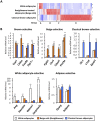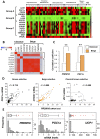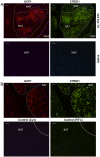Human BAT possesses molecular signatures that resemble beige/brite cells
- PMID: 23166672
- PMCID: PMC3500293
- DOI: 10.1371/journal.pone.0049452
Human BAT possesses molecular signatures that resemble beige/brite cells
Abstract
Brown adipose tissue (BAT) dissipates chemical energy and generates heat to protect animals from cold and obesity. Rodents possess two types of UCP-1 positive brown adipocytes arising from distinct developmental lineages: "classical" brown adipocytes develop during the prenatal stage whereas "beige" or "brite" cells that reside in white adipose tissue (WAT) develop during the postnatal stage in response to chronic cold or PPARγ agonists. Beige cells' inducible characteristics make them a promising therapeutic target for obesity treatment, however, the relevance of this cell type in humans remains unknown. In the present study, we determined the gene signatures that were unique to classical brown adipocytes and to beige cells induced by a specific PPARγ agonist rosiglitazone in mice. Subsequently we applied the transcriptional data to humans and examined the molecular signatures of human BAT isolated from multiple adipose depots. To our surprise, nearly all the human BAT abundantly expressed beige cell-selective genes, but the expression of classical brown fat-selective genes were nearly undetectable. Interestingly, expression of known brown fat-selective genes such as PRDM16 was strongly correlated with that of the newly identified beige cell-selective genes, but not with that of classical brown fat-selective genes. Furthermore, histological analyses showed that a new beige cell marker, CITED1, was selectively expressed in the UCP1-positive beige cells as well as in human BAT. These data indicate that human BAT may be primary composed of beige/brite cells.
Conflict of interest statement
Figures




References
-
- Enerback S, Jacobsson A, Simpson EM, Guerra C, Yamashita H, et al. (1997) Mice lacking mitochondrial uncoupling protein are cold-sensitive but not obese. Nature 387: 90–94. - PubMed
-
- Feldmann HM, Golozoubova V, Cannon B, Nedergaard J (2009) UCP1 ablation induces obesity and abolishes diet-induced thermogenesis in mice exempt from thermal stress by living at thermoneutrality. Cell Metab 9: 203–209. - PubMed
-
- van Marken Lichtenbelt WD, Vanhommerig JW, Smulders NM, Drossaerts JM, Kemerink GJ, et al. (2009) Cold-activated brown adipose tissue in healthy men. N Engl J Med 360: 1500–1508. - PubMed
-
- Virtanen KA, Lidell ME, Orava J, Heglind M, Westergren R, et al. (2009) Functional brown adipose tissue in healthy adults. N Engl J Med 360: 1518–1525. - PubMed
Publication types
MeSH terms
Substances
Grants and funding
LinkOut - more resources
Full Text Sources
Other Literature Sources

